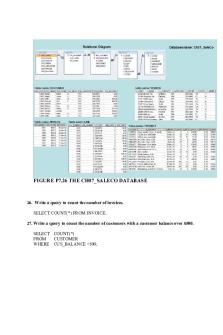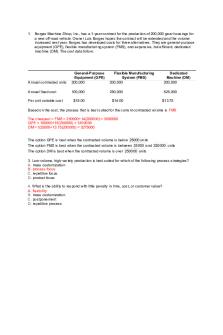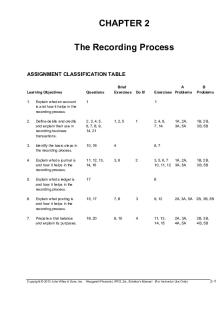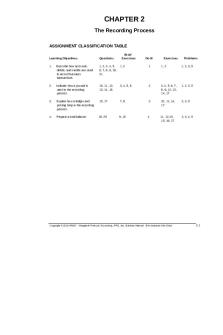SM CH02 - solution manuals CH7 PDF

| Title | SM CH02 - solution manuals CH7 |
|---|---|
| Author | AA AAA |
| Course | Engineering Statics |
| Institution | جامعة الملك فهد للبترول و المعادن |
| Pages | 87 |
| File Size | 5.8 MB |
| File Type | |
| Total Downloads | 7 |
| Total Views | 144 |
Summary
solution manuals CH7...
Description
© 2011 Pearson Education, Inc., Upper Saddle River, NJ. All rights reserved. This material is protected under all copyright laws as they currently exist. No portion of this material may be reproduced, in any form or by any means, without permission in writing from the publisher.
u = 30° T = 6 kN of the resultant force acting on the eyebolt and its direction measured clockwise from the positive x axis.
y
T u
x 45
8 kN
The parallelogram law of addition and the triangular rule are shown in Figs. a and b, respectively. Applying the law of cosines to Fig. b, FR =
62 + 82 – 2(6)(8) cos 75°
= 8.669 kN = 8.67 kN
Ans
Applying the law of sines to Fig. b and using this result, yields sin a sin 75° = 8 8.669
a = 63.05°
Thus, the direction angle f of FR measured clockwise from the positive x axis is f = a – 60° = 63.05° – 60° = 3.05°
Ans
7
© 2011 Pearson Education, Inc., Upper Saddle River, NJ. All rights reserved. This material is protected under all copyright laws as they currently exist. No portion of this material may be reproduced, in any form or by any means, without permission in writing from the publisher.
2–2. If u = 60° and T = 5 kN, determine the magnitude of the resultant force acting on the eyebolt and its direction measured clockwise from the positive x axis.
y
T u
x 45
8 kN
The parallelogram law of addition and the triangular rule are shown in Figs. a and b, respectively. Applying the law of cosines to Fig. b, FR =
52 + 82 – 2(5)(8) cos 105°
= 10.47 kN = 10.5 kN
Ans
Applying the law of sines to Fig. b and using this result, yields sin a sin 105° = 8 10.47
a = 47.54°
Thus, the direction angle f of FR measured clockwise from the positive x axis is f = a – 30° = 47.54° – 30° = 17.5°
Ans
8
© 2011 Pearson Education, Inc., Upper Saddle River, NJ. All rights reserved. This material is protected under all copyright laws as they currently exist. No portion of this material may be reproduced, in any form or by any means, without permission in writing from the publisher.
2–3. If the magnitude of the resultant force is to be 9 kN directed along the positive x axis, determine the magnitude of force T acting on the eyebolt and its angle u .
y
T u
x 45
8 kN
The parallelogram law of addition and the triangular rule are shown in Figs. a and b, respectively. Applying the law of cosines to Fig. b, T=
82 + 92 – 2(8)(9) cos 45°
= 6.571 kN = 6.57 kN
Ans
Applying the law of sines to Fig. b and using this result, yields sin (90° – u) sin 45° = 8 6.571 u = 30.6°
Ans
9
© 2011 Pearson Education, Inc., Upper Saddle River, NJ. All rights reserved. This material is protected under all copyright laws as they currently exist. No portion of this material may be reproduced, in any form or by any means, without permission in writing from the publisher.
*2–4. Determine the magnitude of the resultant force acting on the bracket and its direction measured counterclockwise from the positive u axis.
F2
v
150 N
30 u
30 45
F1
200 N
The parallelogram law of addition and the triangular rule are shown in Figs. a and b, respectively. Applying the law of cosines to Fig. b, FR =
2002 + 1502 – 2(200)(150) cos 75°
= 216.72 N = 217 N
Ans
Applying the law of sines to Fig. b and using this result, yields sin a sin 75° = 200 216.72
a = 63.05°
Thus, the direction angle f of FR measured clockwise from the positive x axis is f = a – 60° = 63.05° – 60° = 3.05°
Ans
N N
N
10
N
© 2011 Pearson Education, Inc., Upper Saddle River, NJ. All rights reserved. This material is protected under all copyright laws as they currently exist. No portion of this material may be reproduced, in any form or by any means, without permission in writing from the publisher.
v
F2
v
150 N
and determine the magnitudes of these components. 30 30 u 45 F1
200 N
The parallelogram law of addition and the triangular rule are shown in Figs. a and b, respectively. Applying the law of sines to Fig. b, yields Fu 200 = sin 105° sin 30°
F u = 386 N
Ans
Fv 200 = sin 45° sin 30°
F v = 283 N
Ans
N N
11
© 2011 Pearson Education, Inc., Upper Saddle River, NJ. All rights reserved. This material is protected under all copyright laws as they currently exist. No portion of this material may be reproduced, in any form or by any means, without permission in writing from the publisher.
2–6. Resolve F2 into components along the u and v axes, and determine the magnitudes of these components.
F2
v
150 N
30 30
u
45
F1
The parallelogram law of addition and the triangular rule are shown in Figs. a and b, respectively. Applying the law of sines to Fig. b, Fu 150 = sin 30° sin 30° Fv 150 = sin 120° sin 30°
F u = 150 N
Ans
F v = 260 N
Ans
12
200 N
© 2011 Pearson Education, Inc., Upper Saddle River, NJ. All rights reserved. This material is protected under all copyright laws as they currently exist. No portion of this material may be reproduced, in any form or by any means, without permission in writing from the publisher.
2–7. If FB = 2 kN and the resultant force acts along the positive u axis, determine the magnitude of the resultant force and the angle u.
y
FA u 30
B
Applying the law of sines to Fig. b, yields
sin f sin 30° = 3 2
f = 48.59°
Thus, u = 30° + f = 30° + 48.59° = 78.59° = 78.6°
Ans
With the result u = 78.590, applying the law of sines to Fig. b again, yields FR sin (180° – 78.59°)
=
2 sin 30°
F R = 3.92 kN
13
Ans
x
A
u FB
The parallelogram law of addition and the triangular rule are shown in Figs. a and b, respectively.
3 kN
© 2011 Pearson Education, Inc., Upper Saddle River, NJ. All rights reserved. This material is protected under all copyright laws as they currently exist. No portion of this material may be reproduced, in any form or by any means, without permission in writing from the publisher.
*2–8. If the resultant force is required to act along the positive u axis and have a magnitude of 5 kN, determine the required magnitude of FB and its direction u.
y
FA
3 kN x
u 30
B
u FB
The parallelogram law of addition and the triangular rule are shown in Figs. a and b, respectively. Applying the law of cosines to Fig. b,
FB =
32 + 52 – 2(3)(5) cos 30°
= 2.832 kN = 2.83 kN
Ans
Using this result and realizing that sin (180° – u) = sin u, the application of the sine law to Fig. b, yields sin u sin 30° = 5 2.832
u = 62.0°
Ans
14
A
© 2011 Pearson Education, Inc., Upper Saddle River, NJ. All rights reserved. This material is protected under all copyright laws as they currently exist. No portion of this material may be reproduced, in any form or by any means, without permission in writing from the publisher.
FA
as shown. If u = 60° , determine the magnitude of the resultant of these two forces and its direction measured clockwise from the horizontal.
u
A
40 B FB
Parallelogram Law : The parallelogram law of addition is shown in Fig. (a). Trigonometry : Using law of cosines [Fig. (b)], we have FR =
82 + 62 – 2(8)(6) cos 100°
= 10.80 kN = 10.8 kN
Ans
The angleu can be determined using law of sines [Fig. (b)]. sin u sin 100° = 6 10.80 sin u = 0.5470 u = 33.16° Thus, the direction f of FR measured from the x axis is f = 33.16° – 30° = 3.16°
Ans
15
6 kN
8 kN
© 2011 Pearson Education, Inc., Upper Saddle River, NJ. All rights reserved. This material is protected under all copyright laws as they currently exist. No portion of this material may be reproduced, in any form or by any means, without permission in writing from the publisher.
2–10. Determine the angle of u for connecting member A to the plate so that the resultant force of FA and FB is directed horizontally to the right.Also, what is the magnitude of the resultant force?
FA u
8 kN
A
40 B 6 kN
FB
Parallelogram Law : The parallelogram law of addition is shown in Fig. (a). Trigonometry : Using law of sines [Fig. (b)], we have sin (90° – u) sin 50° = 6 8 sin (90° – u) = 0.5745 u = 54.93° = 54.9°
Ans
From the triangle, u = 180° – (90° – 54.93°) – 50° = 94.93°. Thus, using law of cosines, the magnitude of FR is FR =
82 + 62 – 2(8)(6) cos 94.93°
= 10.4 kN
Ans
2–11. If the tension in the cable is 400 N, determine the magnitude and direction of the resultant force acting on the pulley. This angle is the same angle u of line AB on the tailboard block.
y
400 N 30
u B A
FR =
(400)2 + (400)2 – 2(400)(400) cos 60° = 400 N
sin 60° sin u = ; u = 60° 400 400
Ans
Ans
16
x 400 N
© 2011 Pearson Education, Inc., Upper Saddle River, NJ. All rights reserved. This material is protected under all copyright laws as they currently exist. No portion of this material may be reproduced, in any form or by any means, without permission in writing from the publisher.
*2–12. The device is used for surgical replacement of the knee joint. If the force acting along the leg is 360 N, determine its components along the x and y ¿ axes.
y¿
y 10
x¿ x 60 360 N
360 –F x = ; F x = –125 N sin 20° sin 100°
Ans
F y = 360 ; F = 317 N y sin 60° sin 100°
Ans
171 7
© 2011 Pearson Education, Inc., Upper Saddle River, NJ. All rights reserved. This material is protected under all copyright laws as they currently exist. No portion of this material may be reproduced, in any form or by any means, without permission in writing from the publisher.
y¿
knee joint. If the force acting along the leg is 360 N, determine its components along the x¿ and y axes.
y 10
x¿ x 60 360 N
360 –F x = ; F x = –183 N sin 80° sin 30°
Ans
Fy 360 = ; F y = 344 N sin 80° sin 70°
Ans
18
© 2011 Pearson Education, Inc., Upper Saddle River, NJ. All rights reserved. This material is protected under all copyright laws as they currently exist. No portion of this material may be reproduced, in any form or by any means, without permission in writing from the publisher.
2–14. Determine the design angle (0° 90°) for strut AB so that the 800-N horizontal force has a component of 1000 N directed from A towards C. What is the component of force acting along member AB? Take 40°.
800 N A u B
f
C
Parallelogram Law : The parallelogram law of addition is shown in Fig. (a). Trigonometry : Using law of sines [Fig. (b)], we have sin 40° sin = 800 1000 sin = 0.8035 = 53.46° = 53.5° Thus,
800 N
Ans
= 180° – 40° – 53.46° = 86.54° 1000 N
Using law of sines [Fig. (b)] 800 F AB = sin 40° sin 86.54°
1000 N
FAC = 1242 N
Ans 800 N
2–15. Determine the design angle (0° 90°) between struts AB and AC so that the 800 N horizontal force has a component of 1200 N which acts up to the left, in the same direction as from B towards A. Take 30°.
800 N A u B
f
C
Parallelogram Law : The parallelogram law of addition is shown in Fig. (a). Trigonometry : Using law of cosines [Fig. (b)], we have FAC =
1200 N
800 2 + 1200 2 – 2(800)(1200) cos 30°
= 645.93 N The angle
800 N
can be determined using law of sines [Fig. (b)].
sin
sin 30° = 645.93 800 sin = 0.6193 = 38.3°
1200 N
Ans 800 N
19
© 2011 Pearson Education, Inc., Upper Saddle River, NJ. All rights reserved. This material is protected under all copyright laws as they currently exist. No portion of this material may be reproduced, in any form or by any means, without permission in writing from the publisher.
v
*2–16. Resolve F1 into components along the u and v axes and determine the magnitudes of these components.
F1
F2
150 N
30
250 N
u
30 105
Sine law : F 1v = 250 sin 30° sin 105°
F 1v = 129 N
Ans
F 1u = 250 sin 45° sin 105°
F 1u = 183 N
Ans
v
v and determine the magnitudes of these components.
F1
F2
150 N
30
30 105
Sine law : F 2v = 150 sin 30° sin 75°
F 2v = 77.6 N
Ans
F 2u = 150 sin 75° sin 75°
F 2u = 150 N
Ans
20
250 N
u
© 2011 Pearson Education, Inc., Upper Saddle River, NJ. All rights reserved. This material is protected under all copyright laws as they currently exist. No portion of this material may be reproduced, in any form or by any means, without permission in writing from the publisher.
2–18. The truck is to be towed using two ropes. Determine the magnitudes of forces FA and FB acting on each rope in order to develop a resultant force of 950 N directed along the positive x axis. Set u = 50° .
y
FA A
B
u FB
Parallelogram Law : The parallelogram law of addition is shown in Fig. (a). Trigonometry : Using law of sines [Fig. (b)], we have FA sin 50°
=
950 sin 110°
FA = 774 N
Ans
950 FB = sin 110° sin 20° FB = 346 N
Ans
2–19. The truck is to be towed using two ropes. If the resultant force is to be 950 N, directed along the positive x axis, determine the magnitudes of forces FA and FB acting on each rope and the angle u of FB so that the magnitude of FB is a minimum. FA acts at 20° from the x axis as shown.
y
FA
A
B
u FB
Parallelogram Law : In order to produce a minimum force FB, FB has to act perpendicular to FA. The parallelogram law of addition is shown in Fig. (a). Trigonometry : Fig. (b). FB = 950 sin 20° = 325 N
Ans
FA = 950 cos 20° = 893 N
Ans
u = 90° – 20° = 70.0°
Ans
The angle u is
21
© 2011 Pearson Education, Inc., Upper Saddle River, NJ. All rights reserved. This material is protected under all copyright laws as they currently exist. No portion of this material may be reproduced, in any form or by any means, without permission in writing from the publisher.
*2–20. If f = 45°, F1 = 5 kN , and the resultant force is 6 kN directed along the positive y axis, determine the required magnitude of F2 and its direction u .
F1 y f u F2
60
The parallelogram law of addition and the triangular rule are shown in Figs. a and b, respectively. Applying the law of cosines to Fig. b,
F2 =
62 + 52 – 2(6)(5) cos 45°
= 4.310 kN = 4.31 kN
Ans
Using this result and applying the law of sines to Fig. b, yields sin u sin 45° = 5 4.310
u = 55.1°
Ans
22
x
© 2011 Pearson Education, Inc., Upper Saddle River, NJ. All rights reserved. This material is protected under all copyright laws as they currently exist. No portion of this material may be reproduced, in any form or by any means, without permission in writing from the publisher.
f = 30° directed along the positive y axis, determine the magnitudes of F1 and F2 and the angle u if F2 is required to be a minimum.
F1 y f u F2
60
For F2 to be minimum, it has to be directed perpendicular to FR. The parallelogram law of addition and triangular rule are shown in Figs. a and b, respectively. By applying simple trigonometry to Fig. b, F1 = 6 cos 30° = 5.20 kN F2 = 6 sin 30° = 3 kN
Ans Ans
u = 90° – 30° = 60°
Ans
and
23
x
© 2011 Pearson Education, Inc., Upper Saddle River, NJ. All rights reserved. This material is protected under all copyright laws as they currently exist. No portion of this material may be reproduced, in any form or by any means, without permission in writing from the publisher.
2–22. If f = 30° , F1 = 5 kN , and the resultant force is to be directed along the positive y axis, determine the magnitude of the resultant force if F2 is to be a minimum. Also, what is F2 and the angle u?
F1 y f u F2
60
Parallelogram Law and Triangular Rule: The parallelogram law of addition and triangular rule are shown in Figs. a and b, respectively. For F2 to be minimum, it must be directed perpendicular to the resultant force. Thus, u = 90°
Ans
By applying simple trigonometry to Fig. b, F2 = 5 sin 30° = 2.50 kN
Ans
FR = 5 cos 30° = 4.33 kN
Ans
24
x
© 2011 Pearson Education, Inc., Upper Saddle River, NJ. All rights reserved. This material is protected under all copyright laws as they currently exist. No portion of this material may be reproduced, in any form or by any means, without permission in writing from the publisher.
2–23. If u = 30° and F2 = 6 kN , determine the magnitude of the resultant force acting on the plate and its direction measured clockwise from the positive x axis.
y F3
5 kN F2
Parallelogram law and Triangular Rule: This problem can be solved by adding the forces successively, using the parallelogram law of addition, shown in Fig. a. Two triangular force diagrams, shown in Figs. b and c, can be derived from the parallelogram. u
as follows.
F1
tan a =
5 4
FR =
62 + 6.4032 – 2(6)(6.403) cos (51.34° + 30°)
a = 51.34°
= 8.09 kN sin b = sin (51.34° + 30°) 6 8.089
Ans b = 47.16°
Thus, the direction angle f of FR , measured clockwise from the positive x axis, is f = a + b = 51.34° + 47.16° = 98.5°
Ans
25
4 kN x
© 2011 Pearson Education, Inc., Upper Saddle River, NJ. All rights reserved. Thi...
Similar Free PDFs

SM CH02 - solution manuals CH7
- 87 Pages

Libby 10e Ch02 SM - solution manual
- 62 Pages

ER8e SM Ch02 - Practice
- 6 Pages

ER7e SM Ch02 - inter finance
- 6 Pages

HW Week2 Solution ch02
- 6 Pages

CF1 Exercise Ch7 Solution
- 4 Pages

HORN Ch08 SM - solution
- 71 Pages

Sm ch - SOLUTION MANUAL
- 43 Pages

Ch7 - Ch7
- 11 Pages

Ch 1 SM - Solution Manauel
- 4 Pages

Ch7
- 4 Pages

Fmhm-lab-manuals
- 75 Pages

Ch02
- 66 Pages

Ch02
- 60 Pages
Popular Institutions
- Tinajero National High School - Annex
- Politeknik Caltex Riau
- Yokohama City University
- SGT University
- University of Al-Qadisiyah
- Divine Word College of Vigan
- Techniek College Rotterdam
- Universidade de Santiago
- Universiti Teknologi MARA Cawangan Johor Kampus Pasir Gudang
- Poltekkes Kemenkes Yogyakarta
- Baguio City National High School
- Colegio san marcos
- preparatoria uno
- Centro de Bachillerato Tecnológico Industrial y de Servicios No. 107
- Dalian Maritime University
- Quang Trung Secondary School
- Colegio Tecnológico en Informática
- Corporación Regional de Educación Superior
- Grupo CEDVA
- Dar Al Uloom University
- Centro de Estudios Preuniversitarios de la Universidad Nacional de Ingeniería
- 上智大学
- Aakash International School, Nuna Majara
- San Felipe Neri Catholic School
- Kang Chiao International School - New Taipei City
- Misamis Occidental National High School
- Institución Educativa Escuela Normal Juan Ladrilleros
- Kolehiyo ng Pantukan
- Batanes State College
- Instituto Continental
- Sekolah Menengah Kejuruan Kesehatan Kaltara (Tarakan)
- Colegio de La Inmaculada Concepcion - Cebu

